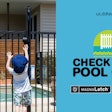After the flood of speculation and analysis that followed the now-infamous Green Olympic Pool Incident of 2016, chemistry expert Bob Lowry provided AQUA the following concise summary along with a couple takeaways in the hope that future embarrassments may be avoided. Lowry is an acknowledged authority in the field of pool chemistry with more than 40 years of experience; he co-owned Leisure Time Chemical and Robarb and has invented more than 110 new products. He is also the author of IPSSA's Basic Training Manual (2016 Revised Edition), Part I — Water Chemistry.
There's lessons to be learned here. First: I believe that they were using an ORP and pH controller. The idiot that added 80 liters had no idea what he was doing. It instantly wiped out any chlorine in the water — but it also gave a false reading on the ORP (oxidation reduction potential). It started reading all the oxidizers in the water. So the ORP reading may have actually gone up, or at least remained near where it was. This would indicate they had a “good” ORP reading.
Then there was no one making a manual reagent test on the water as a backup. A DPD test will also show all oxidizers but not one to one. I am not sure how much 1 ppm of hydrogen peroxide is in ppm free chlorine, but the 80 liters in 1 million gallons would give about 8.5 ppm hydrogen peroxide in the water, minus whatever the chlorine level was at the time. Each ppm of chlorine needs 0.5 ppm hydrogen peroxide. So they could have had a net of about 6 or 7 ppm hydrogen peroxide. This would give a decent ORP. But hydrogen peroxide does a lousy job at destroying ammonia and amine compounds in water, and an even worse job of killing algae. So the ORP looked good but it wasn’t doing much.
If you haven’t seen my definition of ORP, here it is: ORP is the ratio of the difference between all of the oxidizers in the water compared with all of the reducers in the water. Another way of stating this regarding chlorine is that ORP is the ratio of the chlorine residual to the chlorine demand. ORP is not specific for chlorine — it measures all oxidizers in the water compared with all reducers in the water. Oxidizers could include chlorine, bromine, ozone, monopersulfate, hydrogen peroxide and any other sanitizers or disinfectants. Reducers inlcude ammonia, swimmer waste and organic contaminants such as suntan oil, soap, deodorant, hair gel, hair spray, body lotion, sweat, urine, saliva, mucus, dead skin, bacteria, etc. So there was probably no backup testing being done.
On top of that, they claimed that the acid tank was empty. There are supposed to be alarms on the acid and chlorine tanks so they don’t go empty. Who was watching the alarms?
As for the green color, that could be from iron in the water. We usually think of copper or algae. But iron can precipitate when the pH gets near 8 or higher. Iron would look light brown to yellow. The equipment failed to keep up with the pH rise from the pool so probably iron in the water (Rio has older iron pipes) turned the water green since the yellow color from iron against a blue pool surface or against the blue of a deep water pool looks green (yellow+blue = green). When the water is mostly clear and colored, this is almost always chemical and usually metals. Copper is also green, but less likely unless they used a copper-based algaecide (or had a copper heat exchanger get stripped over time from low pH).
We can all learn from this mistake, because it's clear those in charge of the pool didn't know what they were doing.
































![IPSSA’s incoming President Michael Denham [left], Rose Smoot, IPSSA Executive Director [center] and the outgoing President, Todd Starner [right].](https://img.aquamagazine.com/files/base/abmedia/all/image/2024/04/New_IncomingPres_MikeDenham_RoseSmoot_outgoing_president_ToddStarner_IMG_3920_copy.662682e0cbd3a.png?auto=format%2Ccompress&fit=crop&h=112&q=70&rect=0%2C345%2C3024%2C1701&w=112)




